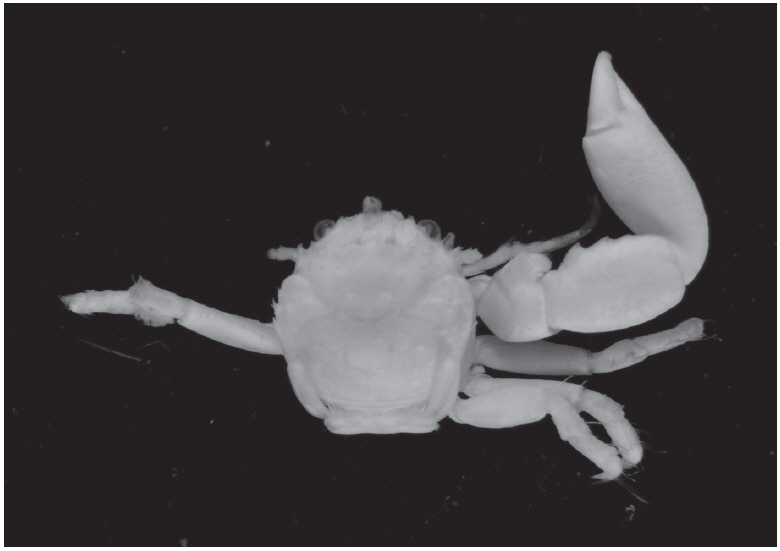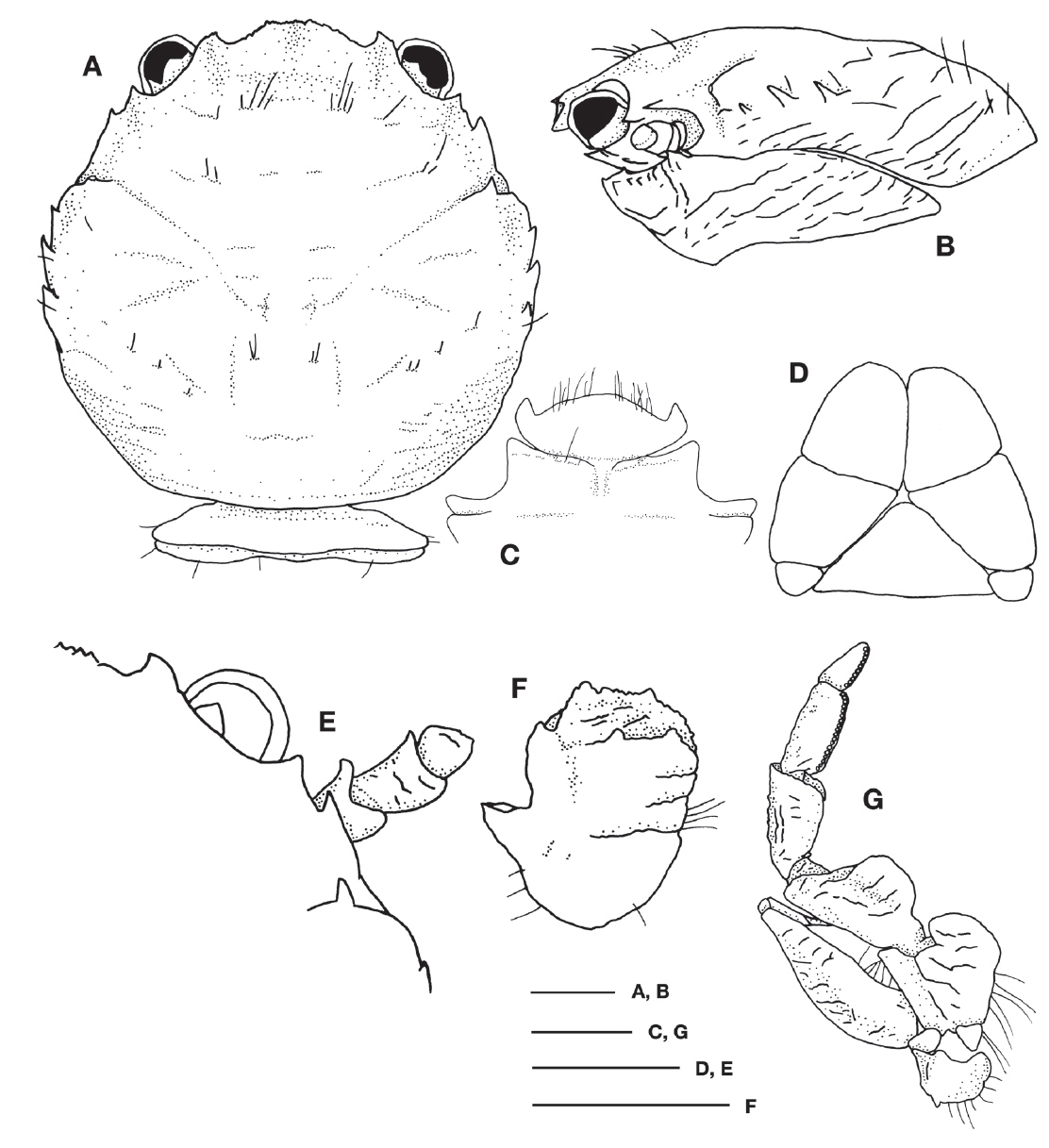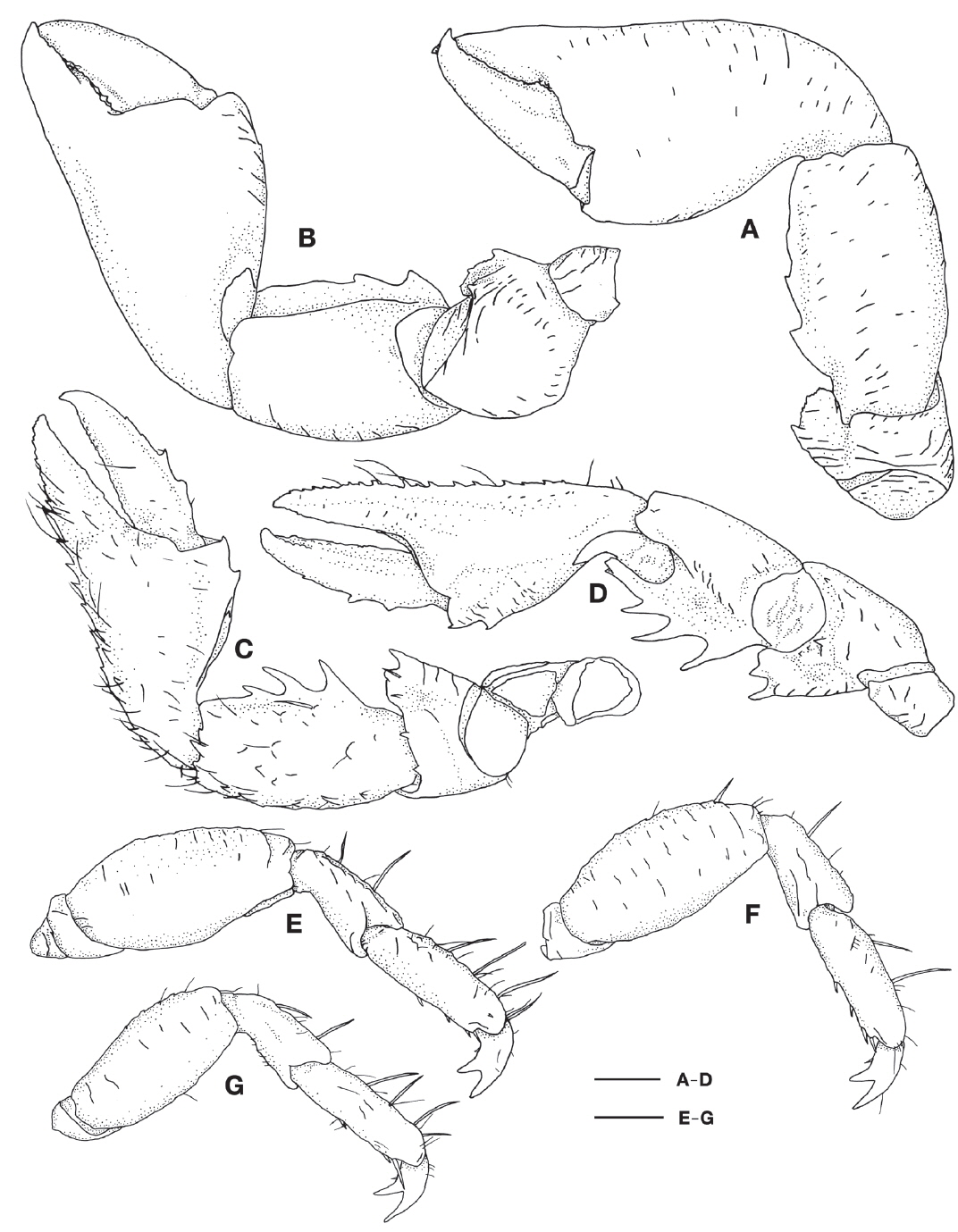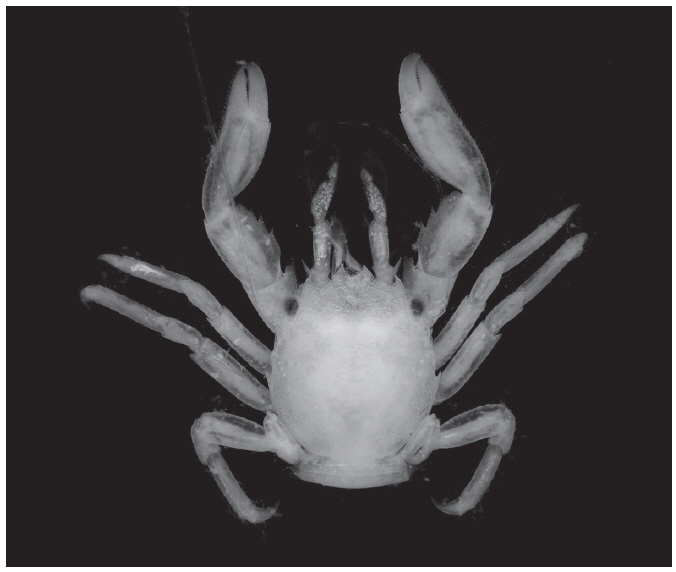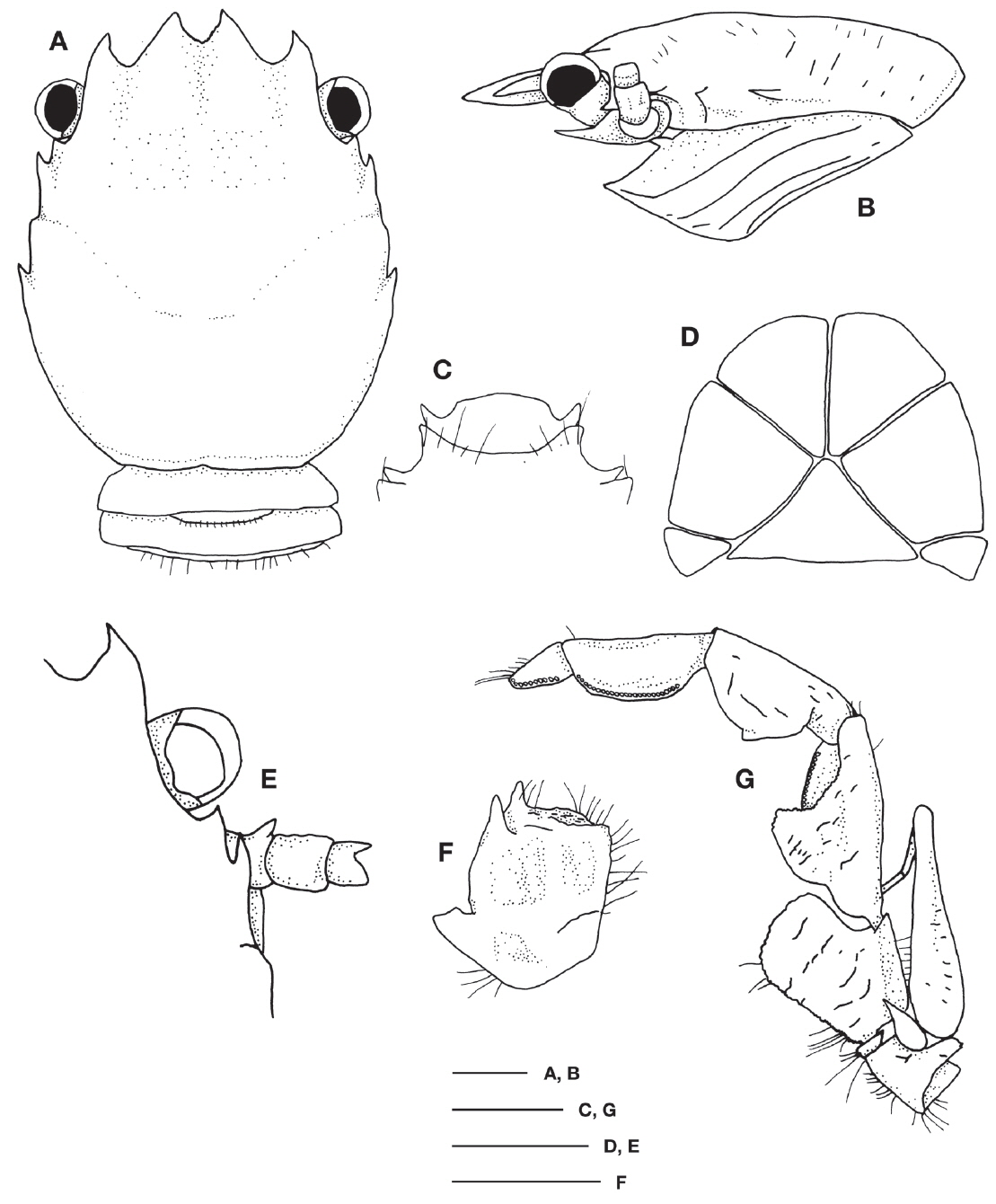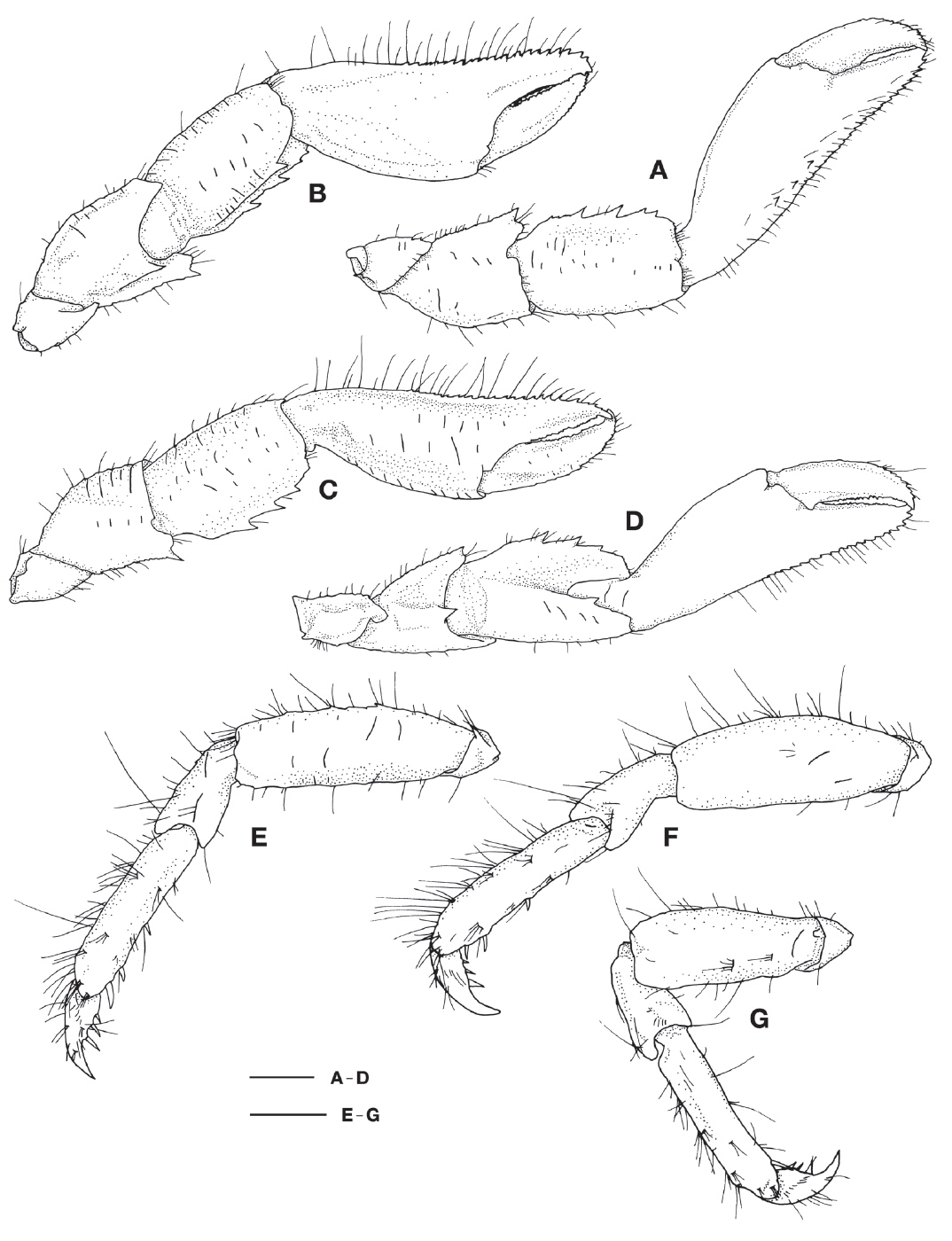



The family Porcellanidae Haworth, 1825, known as porcelain crabs or false crabs, is one of crab-like anomurans. They differ morphologically from true crabs, brachyura, in having 5th pereopod very weakly developed, antennal article with long flagellum, and well developed uropods and telson. They are mainly found in tropical and subtropical waters at depths ranging from 0 to 200 m (Osawa and Chan, 2010).
Ten species belonging to 7 genera of the family Porcellanidae are recorded from Korean fauna (Kamita, 1957; Kim, 1963, 1970; Kim and Choe, 1968; Ko, 2003, 2006). Two porcellanid crabs,
All specimens were collected by SCUBA. The specimens were preserved in 95% ethyl alcohol. All drawings were prepared using camera lucida on a Nikon SMZ800 (Nikon, Tokyo, Japan). Images were taken with a digital camera (Model D7000; Nikon) and were processed with software of Model Helicon Focus (Helicon Soft Ltd., Kharkov, Ukraine). All characters were measured using an analog caliper dialMax 4112102 (Wiha, Schonach, Germany) to the nearest 0.1 mm. The carapace length (CL) was measured from the anterior median part of the rostrum to the posterior median margin of the carapace. Classification follows Ahyong et al. (2011). The specimens examined in this study are deposited into the National Institute of Biological Resources (NIBR).
Order Decapoda Latreille, 1802
Superfamily Galatheoidea Samouelle, 1819
Family Porcellanidae Haworth, 1825
Material examined. 1♂, Korea, Jeju-do, Seogwipo-si, Beophwan-dong, 2 Jul 1993 (NIBR0000323394).
Description. Carapace (Figs. 1, 2A) as long as broad. Dorsal surface moderately convex, with some short transvers ridges bearing stiff setae. Rostrum broad, slightly deflexed, weakly trilobite; median lobe having saw-like teeth; lateral lobe bearing saw-like teeth on anterior margin. Orbit relatively shallow, slightly oblique; supraocular margin unarmed; outer orbital angle having one spine. Protogastric ridge moderately produced. Hepatic margin weakly convex, having one distinct spine. Cervical grooves moderately developed. Branchial margin with some striae, bearing one epibranchial spine and three mesobranchial spines.
Pterygostomian flap (Fig. 2B) entire, rugose, anterior ending with spinule, having two spines on anterodorsal margin.
Third thoracic sternite (Fig. 2C) trilobite on anterior part; median lobe somewhat flat, broad, having setae on anterior margin; lateral lobes narrow. Fourth thoracic sternite with anterior margin slightly broader than third; posterior margin 1.6 times longer than anterior margin; median region concave.
Telson (Fig. 2D) composed of seven plates.
Ocular peduncle (Fig. 2A, E) subcylindrial, short, slightly expanded distally.
Basal article of antennular peduncle (Fig. 2F) 1.18 times as long as broad; anterior margin denticulate; lateral margin having three dentate striae on ventral surface; mesial and lateral margin bearing some setae.
Antennal peduncle (Fig. 2E) moderately slender; first article immovable; second article having one spine on anterodistal margin; third article bearing some striae on dorsal surface, with one spine on anterodistal margin; fourth article unarmed, shorter than others.
Third maxilliped (Fig. 2G) with ischium as long as broad, transversely rugose on ventral surface, anteromesial margin rounded, extensor margin having longitudinal ridge, flexor margin bearing some setae. Merus 1.8 times as long as broad, transversely rugose on ventral surface, and having long seatae on flexor margin to dactylus; flexor margin rounded. Carpus 2 times as long as broad, longitudinal rugae on extensor margin. Propodus 2.25 times as long as broad, relatively slender, nearly smooth. Dactylus small, subtriangular. Exopod somewhat robust, reaching distal end of merus, having some rugae on ventral surface.
Chelipeds unequal. Larger cheliped (Fig. 3A, B) with ischium unarmed, short, having some rugae. Merus rugose; dorsal surface unarmed; ventral surface with one spine on flexor margin; flexor margin having sawlike teeth on anterior region, bearing one spine on median part. Carpus 1.6 times as long as broad; dorsal surface bearing some rugae; flexor margin having three broad spines: proximal spine largest, distal spine faint; ventral surface smooth but extensor margin having some rugae. Chela stout, 1.7 times as long as carpus, 2.3 times as long as broad, lying on extensor side; dorsal surface having some rugae, somewhat convex; ventral surface smooth but flexor margin having some rugae; fingers crossed distally. Fixed finger slightly curved distally, extensor margin unarmed, cutting edge crenulate. Dactylus 0.4 times as long as chela, proximal region of flexor margin slightly depressed, slightly curved distally, cutting edge crenulate.
Smaller cheliped (Fig. 3C, D) with ischium unarmed, short, having some rugae. Merus rugose; dorsal surface bearing three spines on distal edge; flexor margin bearing some rugae, having one spine on anterior region; ventral surface with some spines on distal margin. Carpus 1.7 times as long as broad (excluding spine); dorsal surface bearing some stiff setae; flexor margin having three well developed spines: proximal and median spines same size, distal spine smaller than others; ventral surface having some rugae; extensor margin bearing row of spines; distal end armed with one prominent spine. Chela slender, 1.8 times as long as carpus, 2.4 times as long as broad; dorsal surface having some setae; ventral surface smooth but flexor margin having some rugae; extensor margin bearing row of spines; flexor margin having three spines distally: proximal spine faint; fingers crossed distally. Fixed finger slightly curved distally, cutting edge crenulate. Dactylus 0.5 times as long as chela, proximal region slightly depressed, slightly curved distally, extensor margin having row of spines, cutting edge crenulate.
Ambulatory legs (Fig. 3E-G) relatively short, stout; first and second ambulatory legs subequal; third ambulatory leg smaller than others. Meri 1.9-2.1 times as long as broad, stout, bearing few setae on extensor and flexor margins; dorsal surface having some rugae; extensor margin with row of faint spines. Carpi 2.3 times as long as broad, 0.5-0.7 times as long as merus; dorsal surface having short transverse rugae; extensor margin having stiff setae. Propodi 3.3 times as long as broad, 1.6-1.8 times as long as carpus; dorsal surface with short rugae; extensor margin having stiff setae; flexor margin bearing five (first and second) and four (third) movable spines including distal pair. Dactyli short, having biunguiculate claw; extensor margin bearing few setae; flexor margin having one small movable spine.
Distribution. Red Sea, Gulf of Aden, Persian Gulf, Seychelles, Madagascar, Cargados Carajos (northeast of Mauritius), Gulf of Thailand, Java Sea, Moluccas, New Caledonia, Loyalty Islands, Taiwan and Korea (in this study).
Remarks.
Present specimen is agrees with original description (De Man, 1902) except for the carapace ratio. De Man (1902) mentioned that carapace of
According to Osawa (2007),
Material examined. 1 ovig. ♀, Korea, Jeju-do, Jeju-si, Hallim-eup, Hyeopjae-ri, 24 Sep 2011 (NIBR0000323395).
Description. Carapace (Figs. 4, 5A) 1.27 times as long as broad. Dorsal surface slightly convex, smooth. Rostrum broad, horizontal, trilobite; median lobe broader than lateral lobes, having distinct notch, anterior margin with saw-like teeth, bearing longitudinal groove; lateral lobes sharply end anteriorly. Orbit relatively shallow, strongly oblique; supraocular margin unarmed; outer orbital angle having one spine. Protogastric ridge very weakly produced. Hepatic margin having one distinct spine. Cervical grooves very weakly developed. Branchial margin with one mesobranchial spine.
Pterygostomian flaps (Fig. 5B) entire, rugose, anterior ending with spinule, having one spine on anterodorsal margin.
Third thoracic sternite (Fig. 5C) trilobite on anterior part; median lobe somewhat flat, broad; lateral lobes narrow. Fourth thoracic sternite with anterior margin slightly broader than third; posterior margin 1.46 times longer than anterior margin; median region concave.
Telson (Fig. 5D) composed of seven plates.
Ocular peduncle (Fig. 5A, E) subcylindrical, short, slightly expanded distally.
Basal article of antennular peduncle (Fig. 5F) 1.06 times as long as broad; anterior margin denticulate, having some short striae on ventral surface, bearing two well-developed spines on mesial corner; mesial and lateral margin bearing some setae.
Antennal peduncle (Fig. 5E) moderately slender; first article immovable; second article having one spine on anterodistal margin; third article unarmed; fourth article unarmed, shorter than others.
Third maxilliped (Fig. 5G) with ischium 1.25 times as long as broad, transversely rugose on ventral surface, anteromesial margin denticulate and rounded, extensor margin having longitudinal ridge, flexor margin bearing some setae. Merus 1.8 times as long as broad, having short striae on ventral surface; flexor margin dentate and rounded. Carpus 1.77 times as long as broad, longitudinal rugae on extensor margin. Propodus 2.5 times as long as broad, flexor margin slightly rounded, nearly smooth. Dactylus small, subtriangular. Merus to dactylus having long seatae on flexor margin. Exopod relatively robust, reaching half of merus, having some short rugae on ventral surface.
Chelipeds unequal in size, extensor margin having some setae. Larger cheliped (Fig. 6A, B) with ischium unarmed, short, having some rugae. Merus rugose; ventral surface bearing one distinct spine; flexor margin having saw-like teeth, bearing one spine near anterior distal corner. Carpus 1.6 times as long as broad; dorsal surface bearing some short rugae; dorsoextensor margin unarmed; dorsoflexor margin having four spines: proximal two spines distinct, distal two spines faint; ventral surface having some rugae; ventroflexor margin with one prominent spine on distal third. Chela slender, 2.1 times as long as carpus, 3 times as long as broad, lying on extensor side; extensor margin having row of spines on distal half; ventral surface smooth; fingers crossed distally. Fixed finger slightly curved distally, extensor margin having row of spines, cutting edge crenulate. Dactylus 0.44 times as long as chela, slightly curved distally, cutting edge crenulate.
Smaller cheliped (Fig. 6C, D) similar to larger cheliped; chela slender than that of larger cheliped, 3.25 times as long as broad.
Ambulatory legs (Fig. 6E-G) relatively short, slender. First and second ambulatory legs subequal, third ambulatory leg smaller than others. Meri 2.4-3.0 times as long as broad, slender, extensor margin bearing few setae, with row of faint spines. Carpi 2.2-2.0 times as long as broad, 0.5-0.6 times as long as merus; dorsal surface having short transverse rugae; extensor margin having setae. Propodi 4.2-4.4 times as long as broad, 1.6-1.8 times as long as carpus; dorsal surface with short rugae; extensor margin having setae; flexor margin bearing four (first and second) and three (third) movable spines including distal pair. Dactyli short, having single claw; extensor margin bearing few setae; flexor margin having three movable spines.
Distribution. Southern Japan, New Caledonia, and Korea (in this study).
Remarks. Ten species, associated with sponges, hydrozoans, and anthozoans, are known in the genus
Examined specimen in this study agrees well with the description of Osawa (1998). However, the present specimen reported here has three movable spines on that area while that of Osawa’s (1998) has four spines.
The present species is morphologically similar to


